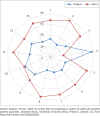Nurse leadership: Sustaining a culture of safety
- PMID: 36337449
- PMCID: PMC9634685
- DOI: 10.4102/hsag.v27i0.2009
Nurse leadership: Sustaining a culture of safety
Abstract
Background: Nurse leaders are essential to manage nursing practices that affect patient safety; therefore, they must create and sustain a sound safety culture in a diverse cultural environment.
Aim: To describe the specific actions required by nurse leadership to enhance the sustainability of a safety culture in hospitals and among a diverse nursing team, ultimately improving patient outcomes.
Setting: Two hospitals in the United Arab Emirates (UAE) were selected purposively, based on the diversity of the nursing team.
Methods: A quantitative design, using Reason's safety culture framework and Ekenedo's behavioural safety model, formed the theoretical background of this study to identify the safety culture and positive work environment that exist among culturally diverse nurses. Thirty-four nurse managers and 417 nurses were conveniently selected to participate. Various instruments were used to gather hospital outcomes and other data from respondents pertaining to their demographics, patient safety, positive work environments and safety culture.
Results: Findings received from the nursing team describe the correlation between patient safety, a diverse nursing workforce and positive work environment affecting a safety culture and promoting positive patient outcomes.
Conclusion: Nurse leaders' integration of specific actions to address the system, as well as diverse nursing teams' behavioural practices, create a patient care environment that adequately contributes to safety culture practices and enhances positive patient outcomes, which are essential for a culture of safety.
Contribution: The study contributes by providing a structured integration of specific actions for nurse leaders to sustain practices ensuring positive patient outcomes.
Keywords: cultural diversity; culture of safety; nursing leadership; patient safety; positive work environment.
© 2022. The Authors.
Conflict of interest statement
The authors declare that they have no financial or personal relationships that may have inappropriately influenced them in writing this article.
Figures
Similar articles
-
International Portuguese Nurse Leaders' Insights for Multicultural Nursing.Int J Environ Res Public Health. 2022 Sep 25;19(19):12144. doi: 10.3390/ijerph191912144. Int J Environ Res Public Health. 2022. PMID: 36231445 Free PMC article.
-
Leadership style and culturally competent care: Nurse leaders' views of their practice in the multicultural care settings of the United Arab Emirates.Contemp Nurse. 2014;48(2):135-49. doi: 10.1080/10376178.2014.11081936. Epub 2014 Jun 20. Contemp Nurse. 2014. PMID: 25549708
-
Nurse leader agency: Creating an environment conducive to support for graduate nurses.J Nurs Manag. 2022 Apr;30(3):643-650. doi: 10.1111/jonm.13561. Epub 2022 Mar 2. J Nurs Manag. 2022. PMID: 35172390 Free PMC article.
-
Authentic leaders creating healthy work environments for nursing practice.Am J Crit Care. 2006 May;15(3):256-67. Am J Crit Care. 2006. PMID: 16632768 Review.
-
Safety culture in health care teams: A narrative review of the literature.J Nurs Manag. 2019 Jul;27(5):871-883. doi: 10.1111/jonm.12740. Epub 2019 Apr 14. J Nurs Manag. 2019. PMID: 30556612 Review.
Cited by
-
Nurse managers' managerial innovation and it's relation to proactivity behavior and locus of control among intensive care nurses.BMC Nurs. 2024 Jul 16;23(1):485. doi: 10.1186/s12912-024-02084-8. BMC Nurs. 2024. PMID: 39014395 Free PMC article.
-
Enhancing Patient Safety Culture in Hospitals.Cureus. 2023 Dec 27;15(12):e51159. doi: 10.7759/cureus.51159. eCollection 2023 Dec. Cureus. 2023. PMID: 38283419 Free PMC article. Review.
-
Prioritization decision-making of care in nursing homes: A qualitative study.Nurs Ethics. 2025 Feb;32(1):42-55. doi: 10.1177/09697330241230513. Epub 2024 Feb 6. Nurs Ethics. 2025. PMID: 38320980 Free PMC article.
-
Enhancing Occupational Health and Safety Through Strategic Leadership: The Mediating Role of Total Quality Management in Hodeida Hospitals, Yemen.Risk Manag Healthc Policy. 2025 Mar 11;18:823-842. doi: 10.2147/RMHP.S506296. eCollection 2025. Risk Manag Healthc Policy. 2025. PMID: 40093374 Free PMC article.
-
Examining patient safety protocols amidst the rise of digital health and telemedicine: nurses' perspectives.BMC Nurs. 2024 Dec 19;23(1):931. doi: 10.1186/s12912-024-02591-8. BMC Nurs. 2024. PMID: 39702255 Free PMC article.
References
-
- Al-Harasis, S., 2012, ‘Impact of language barrier on quality of nursing care at Armed Forces Hospitals, Taif, Saudi Arabia’, Middle East Journal of Nursing 7(4). 10.5742/MEJN.2013.74304 - DOI
-
- Alsalam, G., Bowie, P. & Morrison, J., 2018, ‘Assessing safety climate in acute hospital settings: A systematic review of the adequacy of the psychometric properties of survey measurement tools’, BMC Health Services Research 18, 353, viewed 04 June 2021, from https://www.ncbi.nlm.nih.gov/pmc/articles/PMC5946435/pdf/12913_2018_Arti.... - PMC - PubMed
-
- Attum, B., Hafiz, S., Malik, A. & Shamoon, Z., 2020, Cultural competence in the care of Muslim patients and their families, viewed 24 August 2021, from https://www.ncbi.nlm.nih.gov/books/NBK499933/. - PubMed
LinkOut - more resources
Full Text Sources



